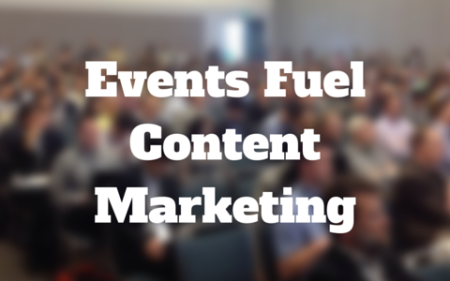
Quick, guess what B2B content marketers named as the most effective content marketing tactic?
OK, the headline probably gave it away, but a whopping seventy-five percent of B2B content marketers rated in-person events as most effective, over white papers, newsletters and blogs.
That’s according to Content Marketing Institute and MarketingProfs research report, “B2B Content Marketing: 2016 Benchmarks, Budgets and Trends — North America.”

From: B2B Content Marketing – 2016 Benchmarks, Budgets and Trends – North America slideshare
After in-person events, the marketers named webinars (66 percent) and case studies (65 percent) as most effective.
Why are events so effective for content marketing? Because they’re structured as a time-bound, content-producing machine: keynotes, panel discussions, training sessions and presentations. All involving people with a shared purpose and shared interests. How could you NOT create interesting content from events?
According to Monina Wagner (@MoninaW), community manager at Content Marketing Institute (CMI), “The key to leveraging in-person events for content marketing is knowing where to unearth ideas.”
Let’s consider five ways you can leverage events to unearth content ideas.
1. Event as a Listening Device
As content marketers, our existence is tied to our target audience. Picking the right events means finding those where we’re surrounded by that audience.
You can learn about your audience via Google Analytics, keyword research and social media listening, but there’s nothing quite like looking them in the eye and speaking to them. You’ll gain an appreciation for their perspectives and challenges in a way that metrics like bounce rate and time on page can’t deliver.
According to CMI’s Wagner, “Events provide an opportunity for an organization to see in real-time what topics resonate with its target audience.”
I want to adjust my own mindset to place a higher importance on listening at events. If I don’t produce a single piece of content from an event, but spent hours talking to my target audience, then I’ll have gained valuable insights.
“Live events give you an opportunity to really hear from your audience. Listening to their questions and challenges and then asking some good follow-up questions will often expose areas where you can fill an important content gap,” said Scott Ingram (@ScottIngram), strategic account executive at Certain.
2. Inspiration for Writing
I love to write. Give me a topic and I’ll dive right in. My challenge is finding things to write about. I prefer to cover a unique topic or delve into a distinct angle. That limits my choices. Sometimes, a comment that I hear at an event will inspire an entire post or article.
My prior CMSWire piece on infographics was inspired by a fellow content marketer. She made a comment about infographics at a Silicon Valley Content Marketing Meetup. On another occasion, I attended a meeting of customer experience professionals. A comment made during a panel discussion inspired me to write about spending more time with customers.
3. Write About the Event Itself
Your target audience is at the event. Others couldn’t make it. If you produce content about the event, both sets of people will be interested.
Last year, I attended Marketo’s annual customer Summit. Because my target audience attends that event, I published a blog post about it, which included six takeaways. Note: Hillary Clinton spoke at the event. One of my takeaways was that she’d run in 2016 (I was right).
For people who could not attend in person, sourcing footage from the event can be an attention grabber. According to Ingram, “Your people are there. What a great time and place to grab some great audio and video content that can be repurposed across multiple channels.”
4. Inform Future Content with Audience Questions
Good content marketing serves to answer questions faced by your target audience. Events are a great place to hear those questions get asked: during technical sessions, breakout sessions, presentations, panel discussions and more.
Write down all of the questions you hear. Next, jot down the answers to the questions. When you return to the office, catalog the questions into topic categories. Determine whether your in-house experts can provide answers that go above and beyond those provided at the event. If they can, you have a nice set of topics for blog posts, webinars, videos, e-books and more.
5. Report on Expert Insights
This is where content marketing meets influencer marketing. All events bring together subject matter experts who are influential in their industry. Put on your reporter hat to write articles about what the experts spoke about.
Recently, I attended a Social Media Club event. An expert panel spoke about social media marketing. The panel shared a number of interesting examples and case studies. The next day, I published a blog post with my takeaways from the panel.
Some of the panel participants saw my post and shared it to their social networks. When you write about someone’s presentation or talk, they’re inclined to share. So reporting on expert insights kills two birds with one stone: you develop content for your target audience, while having the experts share the content on your behalf.
Time to fill up my calendar with meetups, events and conferences. Not only will I hear interesting presentations and meet interesting people, but I’ll have a fresh set of ideas and topics. Given that 75 percent of B2B content marketers find this tactic effective, I’ll see you there. Can we do a short video together?
Notes About this Post
Image adapted from CommScope’s photo on flickr.
This post was originally published at CMSWire.



 Posted by Dennis Shiao
Posted by Dennis Shiao 














